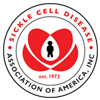Trusted Resources: Evidence & Education
Scientific literature and patient education texts
Elevated tricuspid regurgitant jet velocity, reduced forced expiratory volume in 1 second, and mortality in adults with sickle cell disease
source: American Journal of Hematology
year: 2017
authors: Chaturvedi S, Labib Ghafuri D, Kassim A, Rodeghier M, DeBaun MR
summary/abstract:Cardiopulmonary disease is the leading cause of mortality in adults with sickle cell disease (SCD). Elevated tricuspid regurgitant jet velocity (TRJV) and reduced forced expiratory volume in 1 second (FEV1 ) %predicted are associated with early mortality in SCD; however their relationship and combined effect on survival is unknown. We investigated the relationship between TRJV and FEV1 %predicted, and their combined effect on mortality, in a retrospective cohort of 189 adults with SCD who underwent both pulmonary function testing and echocardiography. Nineteen (9.9%) of 189 patients died over a median follow-up of 1.4 years; cardiopulmonary disease was the major cause of death in 52.6%. FEV1 %predicted was negatively associated with TRJV (Spearman rho, -0.34, P < 0.001). Individuals with FEV1 %predicted ≤70% were more likely to have an elevated TRJV ≥2.5 m/second, compared to those with FEV1 %predicted >70% [45.8% versus 17.1%; odds ratio (OR) 4.1 (95% Confidence interval ([CI] 2.1-8.0); P = 0.001]. In a multivariable cox regression model, the combination of TRJV ≥2.5 m/second and FEV1 %predicted ≤70% predicted earlier mortality [hazard ratio (HR) 4.97 (95% CI 1.30-18.91; P = 0.019)] after adjusting for age, sex, and nephropathy. Both FEV1 %predicted ≤70% and TRJV ≥2.5 m/second were independently associated with nephropathy [OR 4.48 (95% CI 1.51-13.31); P = 0.004] and [OR 3.27 (95% CI 1.19-9.00); P = 0.017], respectively. In conclusion, pulmonary and cardiac impairment are associated with, and contribute to mortality in SCD. Therapies aimed at improving reduced FEV1 %predicted and elevated TRJV could improve survival in patients with SCD.
organization: Vanderbilt University, Nashville; Vanderbilt-Meharry Sickle Cell Disease Center of Excellence, Nashville; Rodeghier Consultants, ChicagoDOI: 10.1002/ajh.24598
read more full text
Related Content
-
Coexistent Sickle Cell Disease Has No Impact on the Safety or Outcome of Lytic Therapy in Acute Ischemic Stroke: Fin...BACKGROUND AND PURPOSE: The recommended ...
-
Restrictive cardiomyopathy is associated with nephropathy in sickle cell anemiaBackground: Cardiopulmonary and renal c...
-
More Online Queries in Winter Suggest Seasonal Variations in SCD ActivityMore people search for information on si...
-
A multiple drug approach to preventing sickle cell crisisSickle cell disease is characterized by ...
-
Virtual Reality Helps Reduce Pain Among Patients With Sickle Cell DiseaseImmersive virtual reality appeared effec...
-
Toronto Neuroscientist Getting Closer to Tailored Treatments for Chronic PainDaily tasks most people don't think too ...
-
Sickle cell and the kidneyhttps://www.youtube.com/watch?v=iK2aLzlc...
To improve your experience on this site, we use cookies. This includes cookies essential for the basic functioning of our website, cookies for analytics purposes, and cookies enabling us to personalize site content. By clicking on 'Accept' or any content on this site, you agree that cookies can be placed. You may adjust your browser's cookie settings to suit your preferences. More Information
The cookie settings on this website are set to "allow cookies" to give you the best browsing experience possible. If you continue to use this website without changing your cookie settings or you click "Accept" below then you are consenting to this.




 +myBinder
+myBinder
